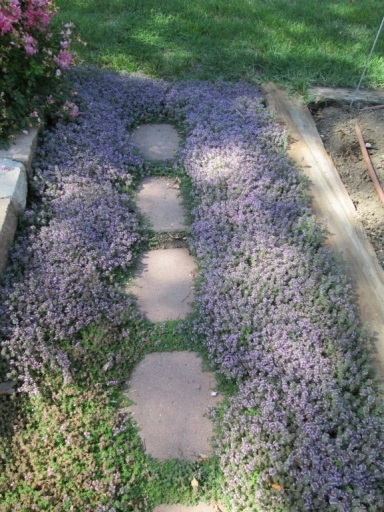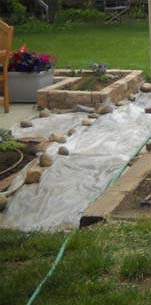What do you do with a narrow grass path, much infested with weeds? I inherited such from the previous home owner and found that it was difficult to mow since it was sunken, and the border of railroad ties necessitated that the grass edges be clipped by hand. I considered replacing the grass with pea gravel, decomposed granite or coarse bark, but a stack of hexagonal concrete pavers discovered in a forgotten corner immediately suggested a solution.
The strip is irrigated by a Netafim subterranean dripper system which is tied in to another area of the garden. It would be a major task to rearrange the pipework, but I could rearrange the plants to considerably reduce the amount of water that both areas needed.
Digging was not feasible because of the embedded underground pipes, but the packaging from a recently delivered mattress provided a ready means to solarize, so I stretched the plastic sheeting over the area and weighted it down with rocks. It was May and I continued to irrigate which encouraged all manner of weeds to germinate but they were quickly destroyed by the heat of our desert sun. I left the plastic in place for the rest of the year just to maximize the effect. The advantage of solarizing rather than digging is that the compacted soil is undisturbed so settling is less of a problem when laying the pavers.

Creeping thyme (Thymus praecox arcticus) is low growing, heat tolerant, and can withstand foot traffic so I raided my daughter's garden for starts to plant between the pavers and along the sides. They were rather poor specimens with not much root and I planted them about 1ft. apart. All grew but were slow to establish. I did not have enough to finish the project but, much later, I found a cell pack of thyme at the local nursery and planted those six plants. They grew much faster, but by the next season it became apparent that the two plantings were of different varieties! “Pink Chinz” has grayish green leaves and flowers later, while “Elfin” - a much tighter grower with tiny leaves and early, minute flowers - was more of a bright green. I do trim the plants around the paving stones once a year to keep the edges defined, and mow the spent flowers but otherwise they have been trouble free with no obvious diseases or pests. It is now three years since I planted and I am not sure how long it will be before the original plants become woody and some sort of replanting will be called for.


Although none of the original weeds grew back, various seedlings had to be removed by hand from the rather large areas between the plants until they filled in so I was pleased that I had not decided to replace an entire lawn. Not much grows through once established, but removing yellow Oxalis corniculata from the depths is tedious and reminds me of a school nurse looking for louse nits! Once in flower weeding can only be done when bees are not around - in the early morning or after the sun goes down. Hive bees love this plant and come by the hundreds daily. So far none of us has been stung while walking along the path, but I don't go bare foot and I encourage children to use an alternative route.
I am delighted with the results – one of my gardening successes even if it is two-tone!
